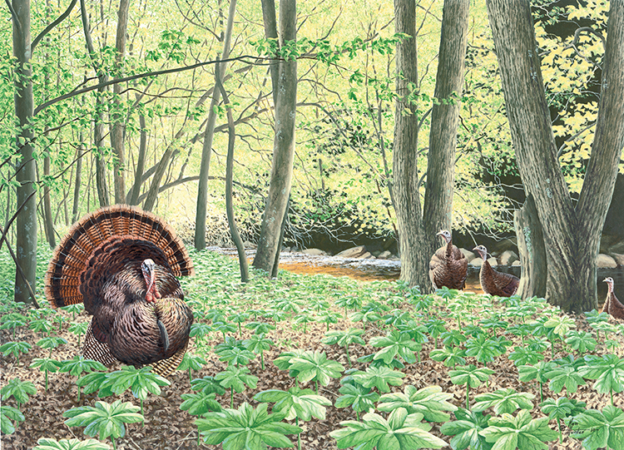Spring turkey hunting will soon be getting underway. It kicks off with the mentored hunters getting the first crack on the Youth Hunt Day on April 26. The regular statewide season runs from May 3 to May 31. Be aware that hunting hours vary. From May 3-17, you can start hunting one-half hour before sunrise and end at noon, but from May 19-31, you can begin one-half hour before sunrise and hunt until one-half hour after sunset.
I’ll be honest: each spring, my mind is all caught up with stream trout fishing or hitting a lake for some crappie fishing, but as the month progresses, my turkey sightings seem to be increasing, and so does my enthusiasm for taking a gobbler. Late last fall, I didn’t seem to see many turkeys during my travels, but that sure has changed in the past month or so. Over the last four or five weeks, I’ve been spotting some good-sized flocks of birds. Earlier this spring, I saw at least four different flocks, some of which had at least three gobblers fanned out. Lately, I’ve seen a fanned-out gobbler with six or eight hens, an occurrence I’ve spotted in several locations. I’ve also had some big gobblers, no doubt, scouting for hens, bolt across the road while driving, and that got my attention.
According to recent studies by the Pennsylvania Game Commission, it appears that the reproduction rate has been sufficient to offset the adult mortality rate, and all factors considered; it appears that the population has increased considerably in the past year. From what I’m seeing, at least in our local area, I would have to agree with that observation. Again, according to Game Commission studies, it appears that the makeup of the flocks could be different in that there may be more three-year-old gobblers than two-year-old gobblers. Three-year-old birds are bigger with longer beards, making them more desirable, but they may also be wiser and harder to call. On the other hand, this increase and mix of gobblers could also make for a greater rivalry for those hens.
So, how successful are Pennsylvania turkey hunters? Last year, we had about 170,400 spring turkey hunters, with similar numbers in 2023. Those hunters took about 39,200 gobblers compared to the three-year average of 34,500. Across Pennsylvania, last spring, one in five turkey hunters, or 20 percent of the hunters, got at least one bird. Those numbers align with 2023 and 2024 but are higher than in 2021 and 2020. Last year, three WMUs came in with over 3,000 gobblers; Unit 2D led the way with 3,600, 2C was next with 3,400, and 2G right here in central Pennsylvania ranked third with 3,000.
Well, according to all those sightings, studies, and numbers, we should have a fairly successful spring turkey hunting season. We turkey hunters also know that a lot goes into a successful turkey hunt, and we also know that a lot can go wrong. In the meantime, I hope I get a chance to add to those positive numbers and studies.




